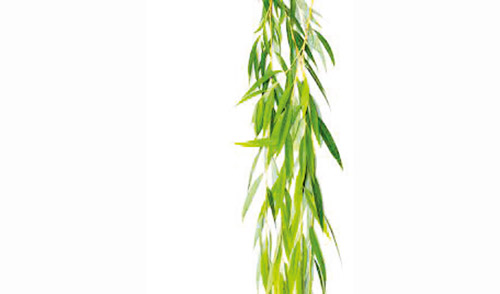
The poor aravah branch, lowest on the arba minim totem pole: unfairly contrasted with the magnificent esrog, the tall and stately lulav, and the fragrant hadasim. There lies the willow branch, boasting neither taste nor smell, midrashically symbolic of the Jew without mitzvos or maasim tovim, and—to add insult to injury—forever linked to COVID-19 and all those who now walk around without taste or smell. Sure, we bind the aravah together with the other species of Sukkot; we know that without aravah the mitzvah cannot be fulfilled. But what can we do to rescue the aravah from the ignominy of being the Hufflepuff of the arba minim?
We must remember that there’s something we do with the aravah that no other species can boast. Yes, along with the other three species we do netilah (holding) and na’anuah (waving). But perhaps nowadays we do not adequately remember how the aravah was used during the times of the Beit Hamikdash.
There was also a ritual called hakafah, in which the aravah alone was paraded around the altar each day of Sukkot, according to Tosfot on Sukkah 45a (the Rambam in Hilchot Lulav holds this was done with all arba minim). Everyone agrees, however, that the aravah alone was used for zekifah. Here is how the Rambam describes it:
הלכה למשה מסיני שמביאין במקדש ערבה אחרת חוץ מערבה שבלולב, ואין אדם יוצא ידי חובתו בערבה שבלולב, ושיעורה אפילו עלה אחד בבד אחדIt is a law from Moshe on Sinai that we bring to the Mikdash an aravah separate from the aravah attached to the lulav, and one cannot fulfill this mitzvah using the aravah from the lulav, and its (minimum) measurement is even one leaf on one stem.
כיצד היתה מצותה, בכל יום ויום משבעת הימים היו מביאין מורביות של ערבה וזוקפין אותן על צדדי המזבח וראשיהן כפופין על גבי המזבח, ובעת שהיו מביאין אותה וסודרין אותה תוקעין ומריעין ותוקעין.What was its mitzvah? On each of the seven days they would bring bunches of willows and lean them on the sides of the altar with their heads bent over the top of the altar. And when they would arrange them they would blow a tekiah, teruah and tekiah.
The altar in the Beit Hamikdash was decorated for Sukkot. Zekifah means that aravot were brought in and completely encased the Mizbei’ach. Imagine walking into the courtyard and seeing the verdant willow leaves surrounding its central vessel. The aravah alone was chosen for this honor.
Rav Soloveichik (see Moadei HaRav pp. 57-66) derived a profound message from this peculiar usage of the aravah. It is to remind all of us that the simplest Jew can have the same emunah as the most lauded Jew. That their mesirat nefesh can be the same. Even the am ha’aretz can be at home at the altar, the location for sacrifice. The stirrings of faith within the Jew are not limited to those within the halls of yeshiva or communities steeped in Torah institutions. The Mizbei’ach is specifically festooned with the aravot, those without טעם וריח, for they teach that v’chol ma’aminim, deep down inside the Jew is always driven to connect to Hashem.
Where did they go to harvest these massive willow branches? The Mishnah tells us:
מִצְוַת עֲרָבָה כֵּיצַד? מָקוֹם הָיָה לְמַטָּה מִירוּשָׁלַיִם וְנִקְרָא ״מוֹצָא״, יוֹרְדִין לְשָׁם וּמְלַקְּטִין מִשָּׁם מוּרְבִּיּוֹת שֶׁל עֲרָבָהHow is the mitzvah of the willow branch fulfilled? There was a place below Jerusalem, and it was called Motza. They would descend there and gather willow branches from there.
The aravah was taken from לְמַטָּה מִירוּשָׁלַיִם, literally underneath Jerusalem, from the lowest place possible, and elevated to a position cresting the top of the altar, bent over in submission, וְרָאשֵׁיהֶן כְּפוּפִין עַל גַּבֵּי הַמִּזְבֵּחַ. The aravah is not bound with the other species simply as an act of compassion and brotherly love. The aravah belongs within this group because of its faithful core and its willingness to sacrifice.
So while you are holding your aravah this year, please think about the brothers and sisters it represents: Those who refuse to mask their Jewish identity or pro-Israel leanings on secular college campuses where the culture has become increasingly hostile. Those who are not necessarily observant but managed to skip work or delay a big project or meeting in order to hear the shofar on Rosh Hashanah or fast on Yom Kippur. The person who made it his or her business to be at a Pesach seder, or say Kaddish or Yizkor, or light Shabbat candles, or turn down shellfish at a company dinner. Jewish pride—which can be challenging to express in today’s complex world—is not the monopoly of the observant community. The unaffiliated Jew’s heart also beats with the nation’s. We parade around with them all seven days of Sukkot, for their sacrifices are real and not to be dismissed.
Rabbi Steven Miodownik is the rabbi of Congregation Ahavas Achim in Highland Park.













